At age 20, Hannah Thornby ’15, an English Writing and Rhetoric major, set out to hike nearly 800 kilometers along El Camino de Santiago and to find out why thousands of others do the same.
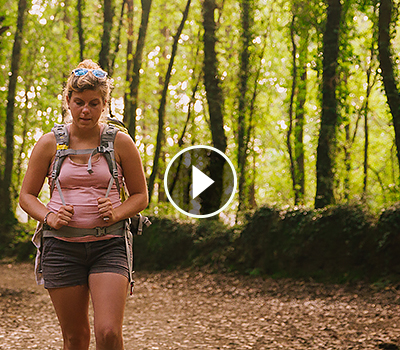
The sun was still rising when I realized I wasn’t alone on the trail. The forest was just thick enough to make the world seem enclosed by the arc of the holm oak tree branches overhead. The open fields of Navarra and vineyards of Rioja lay ahead, and I was savoring the fleeting feeling of a small, private world. Having left Estella in northern Spain that morning, I was roughly 100 kilometers in on my almost 800-kilometer walk across Spain along the French Way of El Camino de Santiago when I caught sight of a fellow pilgrim, Wheelbarrow Man.
I estimated Wheelbarrow Man, with his frizzy white beard and hunched back, to be about 60. He was carrying two sizable packs — one backpacker’s pack and a smaller pack on his front. His companion, a taller, slender, wispy-haired woman speaking French, carried another pack and trailed softly behind as the man dragged the wheelbarrow over rocks and roots and other uneven surfaces. I had been trying to guess their story since I first spotted them on day one in the Pyrenees.
In the six days since I’d begun my journey in Saint Jean Pied de Port, France, I’d confirmed my suspicion that no amount of planning could have prepared me for meeting the wide variety of pilgrims walking the Camino path. They came from places farther away, spoke more languages, and walked for more reasons — reasons I never could have anticipated. In coming together, we asked each other why: Why leave whatever life you’ve left to walk across Spain?
When the trail finally brought me back to Wheelbarrow Man that morning, I broke the silence with the typical pilgrim greeting: Hola, Buen Camino!

In basic conversational French I had picked up at cafés during a study abroad semester in Angers, Wheelbarrow Man and I ran the gamut of ice-breaking trail conversations — Où as-tu commencé? Comment es vos pieds? D’où es-tu? Où va-tu aujourd’hui? (Where did you start? How are your feet? Where are you from? Where are you going today?) — before I launched into what I really wanted to know: Why push a wheelbarrow such a long way along such unfriendly terrain?
Wheelbarrow Man answered in gruffer French than I was used to. All he said, or perhaps all I understood, was that he was carrying everything for his friend. He nodded backward to the wispy-haired Frenchwoman who was looking upward, onward, anywhere but where we were.
It’s impossible to do the Camino alone. The shadow of other pilgrims past and present is as inescapable as rain in Galicia and the sun in the Meseta. Many, under the allure of sharing a trail and a tradition, discard conventions of privacy and immediately open up about the story that led them to the Camino. More often than not, I heard their personal accounts of war, heartbreak, death, dying, love and happiness after walking together for only a few kilometers. They’d often share why they were walking, if they knew. Quite a few did not.
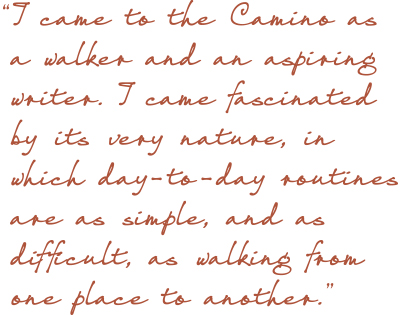
Wheelbarrow Man didn’t break. I had questions about their relationship and how far they had been walking, but mainly, I wanted to know about that wheelbarrow. My muscles sore and my feet already blistered from carrying just one pack, I couldn’t imagine why anyone would freely choose to push a wheelbarrow in the Spanish summer heat, up the mountains of the Pyrenees and down the unexpected valleys in the Rioja.
Neither showed signs of providing more answers. When they stopped, dropping the wheelbarrow and multiple packs to drink some water, I kept on, left with one more mystery to ponder along the Camino.
I came to the Camino as a walker and an aspiring writer. I came fascinated by its very nature, in which day-to-day routines are as simple, and as difficult, as walking from one place to another.
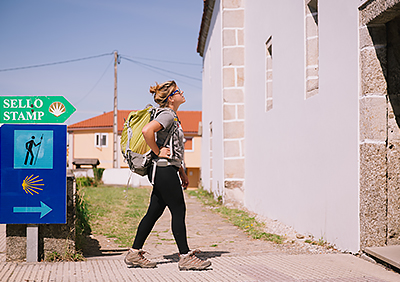
Greek philosophers called the Peripatetics were the first to draw the connection that walking begets thinking. More recent studies in biology demonstrate that physical acts like walking can help restore basic body function: Walking increases the flow of blood and oxygen to more parts of our bodies, especially our brains.
And walking, that physical movement and journey through space and time, has been used by writers as a way to capture the human experience. Beyond medieval Christians and pilgrims who’ve written about the Camino, countless philosophers and literary minds have framed the human struggle around long walks — Kant, Wordsworth, Rousseau and Thoreau, for instance. With the horizon always ahead and the heart and lungs working in unison, walking stimulates us and leads us to something greater.
I traveled to Spain last summer because, as mundane as it may sound, I love walking, and I wanted to write in the ancient space of the Camino, where people have been walking for well over 1,000 years.
The Camino was once mainly a form of plenary indulgence undertaken only by penitent Catholics wishing to become more devout. Today it is a modern cultural phenomenon. In 2013, the trail drew people from more than 130 countries for reasons that ranged from religious to recreational. The demographics of walkers are now so varied that academics are at a loss to define what exactly constitutes a Santiago-bound pilgrim.
I came to the Camino for my chance to join the legacy of walking and writing, but I spent much of my 780 kilometers trying to figure out why so many others come to it in the 21st century. Why pull boots on over blisters and walk through the often-unforgiving elements of northern Spain?
Unlike those medieval pilgrims seeking indulgences in the final Cathedral of Santiago de Compostela where St. James the Great is allegedly buried, only a few I came across were walking to receive forgiveness. The pilgrims I met pushed wheelbarrows and left jobs as doctors, chefs, teachers, artists and farmers to walk a trail that’s hardly what it used to be: The Camino is neither pastoral nor isolated, given the urban sprawl and new cities that have intruded upon the ancient path.
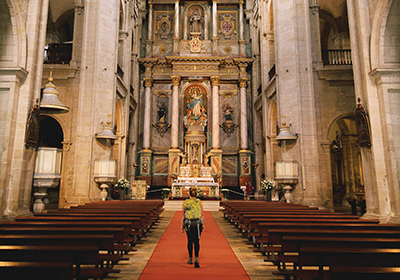
The pilgrims represent any number of religions. The diversity makes for a welcoming and eclectic community that comes together on the trail or in special Camino hostels, as the pilgrims share their experiences with one another.
Nights on the Camino involve sharing cheap pasta dinners, multilingual conversations and often tales of blisters and what the sunrise looked like that morning (almost all wake up before dawn to start walking).
But even after hundreds of kilometers and interactions with other pilgrims as distinct as Wheelbarrow Man, I was left wondering: What does it mean to be a modern-day pilgrim? And was I one?
I’d finally given up on my quest to name and categorize the Camino pilgrim when I met George, a sort of pilgrim expert.
When our paths crossed in Rabanal del Camino on the slow climb into Galicia, he was completing his 11th Camino France (the most popular of the pilgrimage routes to the cathedral) in as many years. He was 81. He would pass me on the trail a number of times.
Both young and old flock to the Camino, and the older walkers often fare better, walking farther or faster than their comparatively healthier, fitter counterparts. Competition on the Camino is looked down upon, but I still wondered about the phenomenon. I’m a long-distance runner, yet people 40 and 50 years older than me were consistently outpacing me, sometimes with no previous trekking experience and sometimes even pushing a wheelbarrow.
It would eventually make me doubt my place along the trail, question my position as a pilgrim.
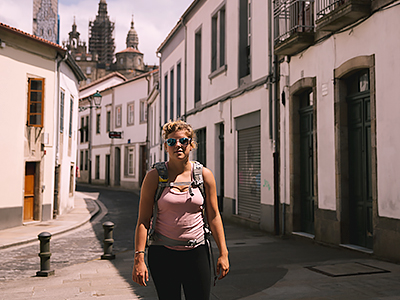
George and I had set out from the same place one morning. After huffing my way into the last mountain village before the climb to the second-highest peak of the trail between France and Spain, I found him having a leisurely tea with a large group of other pilgrims. I’d always find him this way: surrounded by five or six others, laughing and sharing stories from his life and 10 other Caminos.
When, in exasperation, I finally asked how he moved so effortlessly along the trail, he told me that he believed that the older pilgrims fared better than the younger generation because they knew more about suffering, more about dealing with the ups and downs of life. If everyone breaks on the Camino under the physical and mental duress, those with more years under their belt know more about what it’s like to be broken and how to put themselves back together.
Pointing to me and a friend I had picked up along the trail that day, he told us there was a reason he’d done the Camino so many times in lieu of other Christian pilgrimages, like Fátima in Portugal or Lourdes in France.
“You get to walk and talk with people,” he said, with a chuckle, “like yourselves.”
In that simple answer, we were alike in our reasons for walking the Camino: We both came to start walking and see what would happen.
In the summer before my last year of college, I walked 780 kilometers between Saint Jean Pied de Port and Santiago in 33 days. I threw out my hip. I had my backpack bitten, while attached to me, by a donkey. I slept in an abandoned building and a convent. I found myself in the middle of a discussion about the Crusades between an Austrian nun and a death-metal-loving Polish anarchist. I made long-term plans with short-term friends to hike Machu Picchu, attend Oktoberfest and visit Vienna during Christmas. I shared an ice cream with a Polish priest 45 seconds after introductions.
I paid close enough attention to notice when the sunflowers finally turned their faces upward midsummer. I learned to take siesta, to listen and to toast at the end of every day. I saw the human spirit prevail when a stranger insisted on helping another stranger pop oozing blisters. I traveled slowly enough to notice and appreciate the subtle differences in landscape and people that inevitably appear if you keep traveling in one direction. I came to terms with a long-held impulse to prove that I could do everything myself. I became forever indebted to others for their small acts of kindness and realized that living in communion with people was important to me. I used the word “blessed” unironically for the first time in my life.
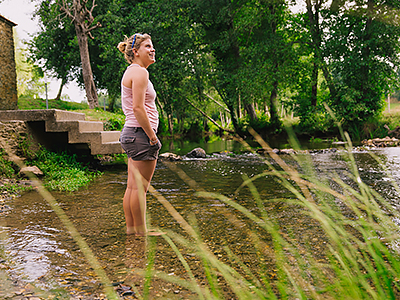
In the end, I identified as a pilgrim, but I still found the whole idea of the Camino too old, too long, too romantic and too esoteric to explain as a writer.
What I do know is that as the sights and the places change on the Camino, the rhythm stays the same. In today’s overtasked, over-stimulated world, it’s an infinitely human-feeling rhythm: wake, walk and rest. Young and old, believers and nonbelievers, those pushing wheelbarrows and those engaging everyone they meet: They become pilgrims when they let the trail, its people and the experiences they share along the Camino into their lives.

Whenever I am stressed, I list the 30 towns I stayed in over the course of my trek, starting in southern France and continuing across most of northern Spain: Saint Jean Pied de Port, Roncesvalles, Larrasoana, Puente la Reina, Estella, the list goes on. Strung together, they sound like a chant and calm me. They remind me of everyone I met along the path.
I miss walking and talking with people every day, but in the almost 12 months since I completed my pilgrimage, I’ve finished an undergraduate honors thesis on my experience on El Camino de Santiago, embedding contemporary and medieval history alongside social research into pilgrims and pilgrimages within a longform creative nonfiction narrative. I have been awarded a Fulbright English Teaching Assistant grant in Malaysia. I graduated with honors from St. Edward’s in May. And I have plans to visit a few members of my Camino family just as soon as time allows.

